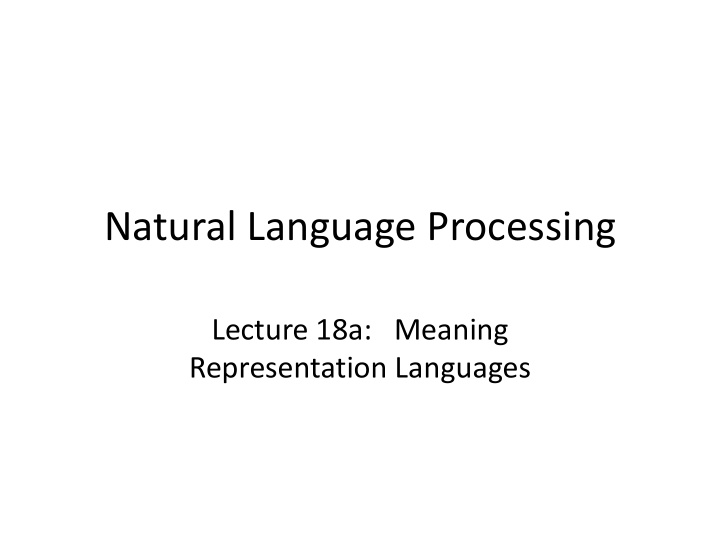



Natural Language Processing Lecture 18a: Meaning Representation Languages
Semantics Road Map 1. Lexical semantics 2. Vector semantics 3. Meaning representation languages and semantic roles 4. Compositional semantics, semantic parsing 5. Discourse and pragmatics
INTENSION AND EXTENSION
Two Approaches to Semantics • Intentional – Assumes that the word or utterance is intrinsically meaningful – Decompositional approaches to lexical semantics are intentional • Extentional – Defines words and utterances by the the things in the world of which they are true – This lecture will concern extentional models of semantics
Extension The meaning of red is the set of entities in the universe of which the predicate RED is true. Similarly, the meaning of hit is the set of <x,y> pairs of which HIT (x, y) is true.
In this lecture… • We will look at ways of representing the extension of verbs and sentences • We will also look at semantic roles and how they relate to meaning representation languages (MRLs)
DESIRABLE PROPERTIES OF MEANING REPRESENTATIONS
Meaning Representation? results of linguistic meaning non-linguistic parsing/WSD/ inputs representation domains coref/SRL/etc. For what kinds of tasks? • Answering essay questions on an exam • Deciding what to order at a restaurant • Learning an activity via instructions • Making an investment decision • Recognizing an insult
Desirable Qualities: Verifiability We want to be able to determine the truth of our representations. “Does Udipi serve vegetarian food”? Is SERVE (Udipi, vegetarian food) in our knowledge base? What is the relationship between the meaning of a sentence and the world as we know it?
Desirable Qualities: Unambiguous Representation Let’s eat somewhere near campus. (e.g., we want to eat at a (e.g., we eat places) place near campus) Our MRL must capture precisely one of these meanings—not both.
Desirable Qualities: Canonical Form • “Mad Mex has vegetarian dishes.” • “They have vegetarian food at Mad Mex.” • “Vegetarian dishes are served at Mad Mex.” • “Mad Mex serves vegetarian fare.” Inputs that mean the same thing should have the same meaning representation.
Desirable Qualities: Inference, Variables, and Expressiveness • “Can vegetarians eat at Mad Mex?” • “I’d like to find a restaurant where I can get vegetarian food.” SERVE (x, vegetarian food) • “Delta flies Boeing 737s from Boston to New York.”
One Limitation: Literality We will focus on the basic requirements for meaning representation. The basic requirements do not include correctly interpreting statements like: • “Ford was hemorrhaging money.” • “I could eat a horse.”
What entities do we want to represent? A meaning representation scheme should let us represent: • objects (e.g., people, restaurants, cuisines) • properties of objects (e.g., pickiness, noisiness, spiciness) • relations between objects (e.g., SERVE (Oishii Bento, Japanese))
The Knowledge Base It contains the We can query it things that we “know” Our knowledge base
THE CANDIDATES
“I have a car.”
FIRST-ORDER LOGIC
MRL #1: First-Order Logic DressCode(ThePorch) Functions Cuisine(Udipi) SERVES (UnionGrill, AmericanFood) Predicates RESTAURANT (UnionGrill) • HAVE (Speaker, FiveDollars) ∧ ¬ HAVE (Speaker, LotOfTime) • ∀ x PERSON (x) ⇒ HAVE (x, FiveDollars) • ∃ x,y PERSON (x) ∧ RESTAURANT (y) ∧ ¬ HASVISITED (x,y)
First Order Logic and Semantics • Nouns correspond to one-place predicates: RESTAURANT (x) is true if x is a member of the set of restaurants • Adjectives correspond to one-place predicates: VEGETARIAN (x) is true if x is a member of the set of things that are vegetarian • Verbs correspond to one-place, two-place, or three- place predicates DINE (x) as in Noah dined. EAT (x, y) as in Noah ate American food . GIVE (x, y, z) as in The bad sushi gave Noah a stomach ache .
<latexit sha1_base64="xaOK769s7M7s4w50+CfpEjQ07Y=">AC73icjVJNixNBEO0ZdV3jV1aPXhqDkoCEyV50bwuCeFzF7C5kQqjpqUya7ekeumuyCcP8Ci8eVLz6d7z5b+xJQtBExIKGx3v1XZ0USjqKop9BeOPmrYPbh3dad+/df/CwfTo3JnSChwKo4y9TMChkhqHJEnhZWER8kThRXL1utEv5midNPoDLQsc5BpOZUCyFOTo+AgTjCTugIlM41p3XrO4zwxiyomXJAT1RwzJLAStEVHUFrQVHeHqSxkr47jxn9qLCjF/8RWHcXPR6/l9nMS9Zc7xRzaOfoGq8XG+V8m+WNMWnd8xXjWTPtXqPb2DW96rD+VxrU6XbsSbsT9aOV8X0w2IAO29jZpP0jTo0oc9QkFDg3GkQFjSuwJIXCuhWXDgsQV5DhyEMNObpxtTpYzZ95JuV+bf5p4iv294gKcueWeI9c6CZ29Ua8m/aqKTpq3EldVESarEuNC0VJ8Ob6/NUWhSklh6AsNL3ysUMLAjyf6TlzDYHXkfDI/7J/3Bu6hz2t1s45A9YU9Zlw3YS3bK3rIzNmQiyIOPwefgS2jDT+HX8NvaNQw2MY/ZHxZ+/wUk4vL8</latexit> Modus Ponens and Forward Chaining As individual facts are added to a knowledge base, modus ponens can be used to fire applicable implication rules.
First Order Logic: Advantages • Flexible • Well-understood • Widely used
DESCRIPTION LOGICS
MRL #2: Description Logics • Goal of description logics: understand and specify semantics for slot-filler representations • More restrictive than FOL
TBox and ABox • TBox: contains the knowledge about categories or concepts in the application domain All bistros are restaurants All restaurants are businesses • ABox: facts about individuals in the domain Udipi is an Indian restaurant
Categories and Subsumption IndianRestaurant(Udipi) category domain element Udipi is an Indian restaurant. IndianRestaurant ⊑ Restaurant subsumed subsumer All Indian restaurants are restaurants.
Negation and Disjunction IndianRestaurant ⊑ not ItalianRestaurant Indian restaurants can’t also be Italian restaurants. Restaurant ⊑ ( or ItalianRestaurant IndianRestaurant MexicanRestaurant) Restaurants are Italian restaurants, Indian restaurants, or Mexican restaurant.
Advantages • Intuitive hierarchical representation • Compatible with existing work on ontologies
LOOKING FORWARD
The Missing Link results of linguistic meaning non-linguistic parsing/WSD/ inputs representation domains coref/SRL/etc. Compositional semantics / semantic parsing
Recommend
More recommend